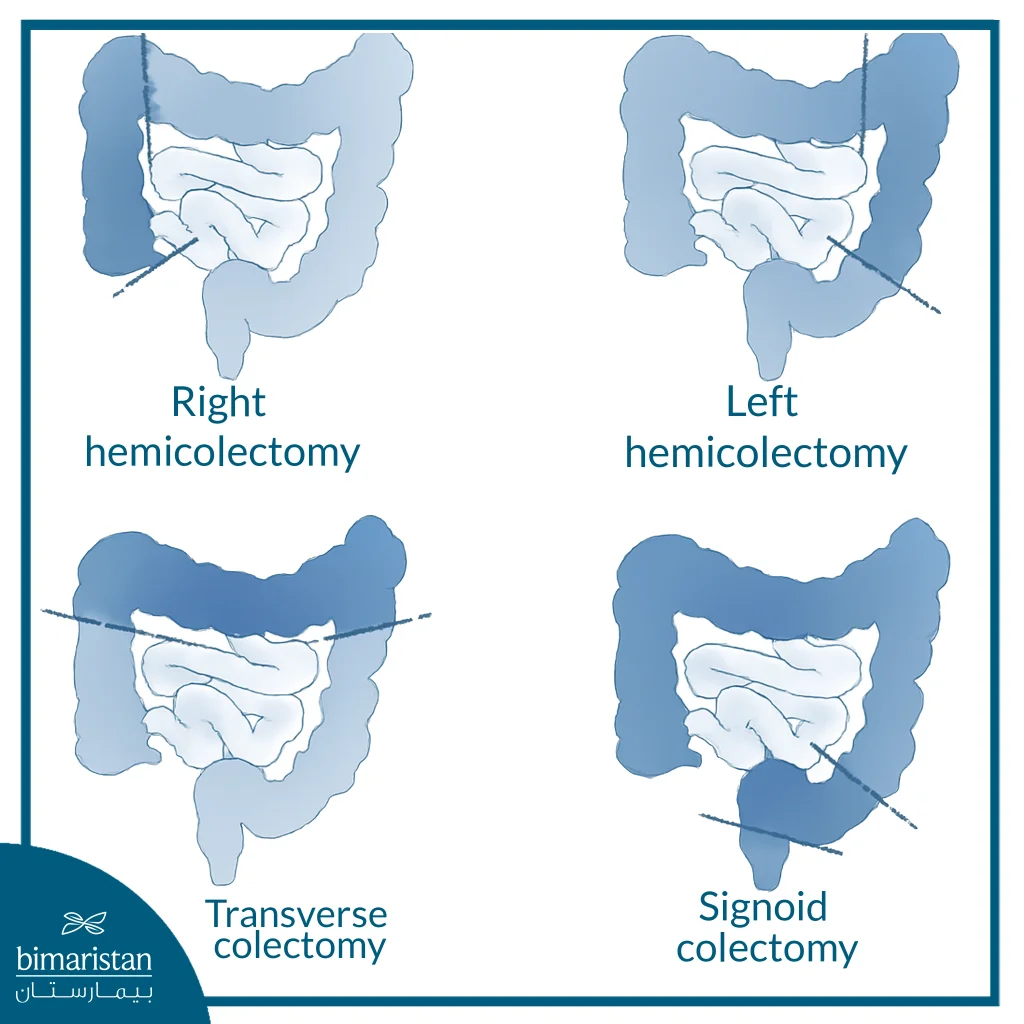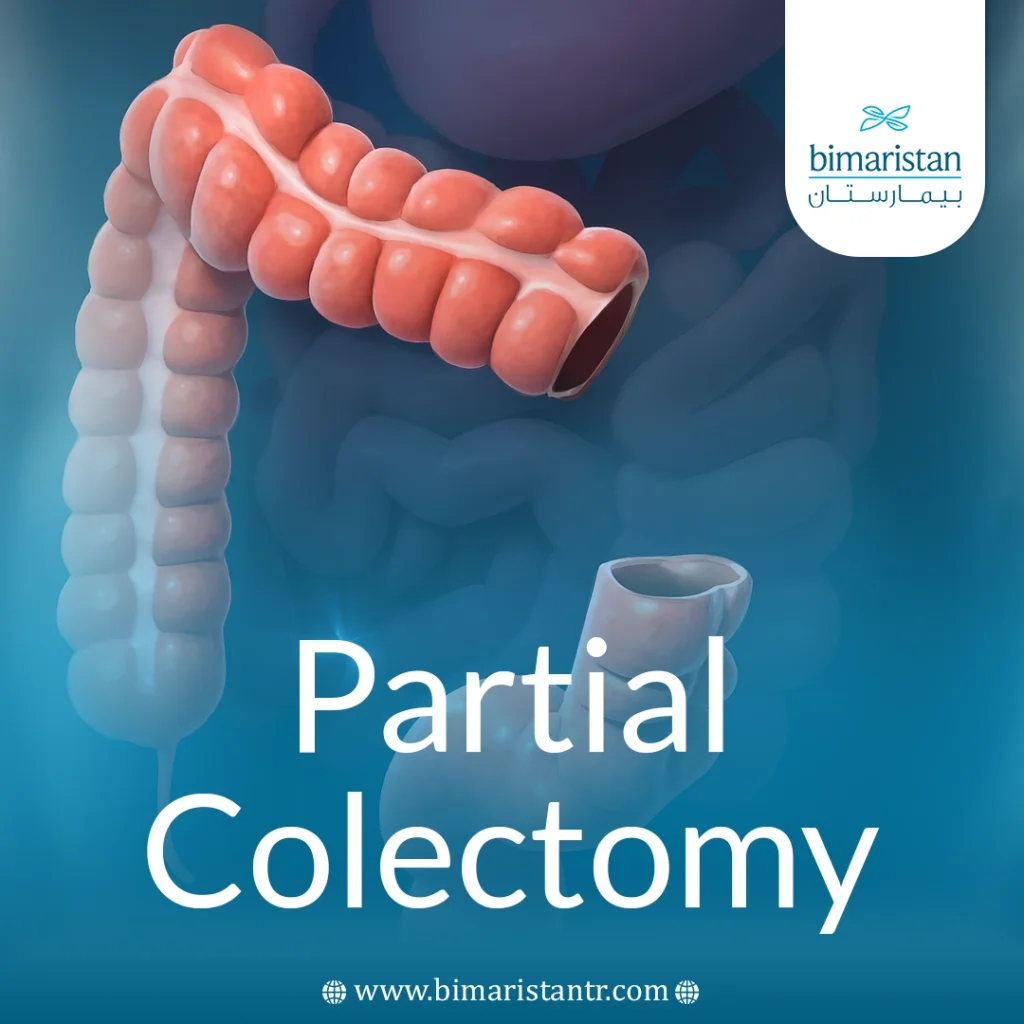Partial colectomy is an effective option to improve patients’ quality of life and minimize the bothersome symptoms associated with colon diseases. It also helps prevent future complications that may threaten the patient’s health.
This article aims to explain the steps of the procedure, its benefits, and potential risks, in addition to providing an overview of treatment options in Turkey, which is one of the most advanced medical destinations for colon surgery, where the latest technologies and specialized medical staff are available.
What is a partial colectomy?
A partial colectomy is a surgical procedure in which a specific part of the affected colon is removed, leaving the rest of the intestine intact and functioning normally. This procedure aims to treat diseases affecting part of the colon without the need to remove the entire colon.
Difference between partial and total colectomy
The difference between partial and total colectomy is as follows:
- Partial resection: Only a specific part of the colon (such as the right or sigmoid colon) is removed, and then the healthy parts are reconnected.
- Total resection: This removes the entire colon and is often performed in severe cases such as metastatic cancer or extensive chronic inflammation.
Types of partial colectomy
Colon resection is performed depending on the location of the lesion, including a partial colectomy:
- Right colectomy
- Left colectomy
- Sigmoid colectomy
- Transverse colectomy

Conditions that require a partial colectomy
Partial colectomy is performed to treat specific diseases that affect part of the colon and do not respond to medical treatment or simple interventions:
- Early-stage colon cancer: Where the cancer is localized to a specific part of the colon, that part is removed to prevent the cancer from spreading.
- Intestinal obstruction or torsion: Occurs when the colon twists in on itself, causing a blockage that prevents the passage of food and waste.
- Large tumors: Especially those that are difficult to remove endoscopically or pose a risk of turning into cancerous tumors.
- Crohn’s disease or ulcerative colitis: If complications such as ulcers or blockage of the colon occur.
- In case of colon bleeding: If the bleeding is frequent or severe and cannot be stopped by other methods.
Preparations before a partial colectomy
Before undergoing a partial colectomy, there are a number of steps that are necessary to ensure the success of the procedure and minimize potential risks:
- Necessary medical tests: Blood tests, radiographs (especially CT scans), and colonoscopies to pinpoint the exact location of the affected area.
- Dietary preparations: Your doctor may recommend following a special low-fiber diet or relying on clear liquids before the procedure to reduce food residue in the intestines.
- Bowel preparation: Use laxatives or colon cleansing solutions before surgery to ensure the bowel is completely empty.
- Stopping certain medications: Your doctor may ask you to stop certain medications, such as blood thinners, that may increase the risk of bleeding during the procedure, with dosages adjusted under your doctor’s supervision.
- Awareness of potential risks: It is essential that the doctor explains to the patient the details of the procedure, its benefits, and possible complications to ensure they are mentally and physically prepared for the surgery.
Methods of partial colectomy
Partial colectomy is performed under general anesthesia in most cases, and the surgeon chooses the appropriate method depending on the patient’s condition and the type of disease. In traditional open surgery, the surgeon makes a longitudinal incision in the abdomen to access and remove the affected colon, and this method is still used, especially in complex or emergency cases. Laparoscopic surgery involves making several small incisions in the abdomen through which precision instruments and a camera are inserted, which allows the affected part of the colon to be removed with precision while minimizing pain and recovery time.
The operation usually takes between two and four hours, during which the affected part of the colon is removed and the healthy parts are reconnected. In most cases, the intestines are reconnected directly, but in some complex cases or when there is severe inflammation, the surgeon may create a temporary colostomy with an external bag to collect waste until the colon is completely healed.

Robotic Surgery and New Technologies
Along with open and laparoscopic surgery, robotic surgery has become an evolving option for partial colectomy. A robotic arm is controlled by the surgeon, enabling precise surgical movements and minimizing the risk of injury to healthy tissue. Robotic surgery is characterized by 1:
- More accurate ablation, especially in complex areas
- Reduce hospitalization and speed recovery
- Optimizing the cosmetic results of abdominal scars
- Less bleeding during the procedure
Recent studies suggest that the outcomes of robotic surgery are similar in terms of safety and efficacy to laparoscopic surgery, but may provide greater surgeon comfort and precision in certain complex cases, such as sigmoid or transverse colon resection.2
Possible complications after partial colectomy
As with all surgeries, a partial colectomy may come with some potential risks or complications, although most patients recover without serious issues. These risks include the following:
- Infection: The incision can become infected, and infections in the lungs (pneumonia) or urinary tract may occur after the procedure, especially in patients who stay in the hospital for a long time.
- Accidental injury to neighboring organs: During surgery, the bowel, bladder, or certain blood vessels near the resection area may be injured, which is usually treated immediately during the procedure.
- Anastomotic leakage: If the intestinal junction does not heal properly, a leak in the colon may occur, leading to infection or bleeding inside the abdomen.
- Surgical hernia: A hernia may form in the abdominal wall due to the weakness of the area that was opened during the operation, and may require subsequent surgical repair.
- Scar tissue formation: As the bowel heals, scar tissue may form that connects the parts of the bowel together. Over time, this can cause partial or total intestinal obstruction that requires additional treatment.
Despite these risks, advances in laparoscopic surgery techniques and post-operative care have greatly reduced their incidence, especially when performed by surgeons who specialize in the colon and gastrointestinal tract.

Recovery and care after partial colectomy
The post-partial colectomy period is a crucial phase of the treatment journey, focusing on healing the intestines and gradually restoring digestive function. Recovery time varies from person to person, but it usually lasts between 4 and 6 weeks, depending on the type of operation (laparoscopic or open surgery) and the patient’s overall health status. After the operation, the patient remains in the hospital for two to four days under close medical monitoring:
- Managing pain with prescription medications
- Monitor bowel function and make sure it gradually returns to normal
- Preventing infection or bleeding through antibiotics and wound care
- If a stoma (external bag) is present, the patient is trained on how to safely clean and replace it
During the first few hours after surgery, the patient is allowed to consume only clear liquids, then gradually move on to:
- Soft foods such as soup or boiled potatoes
- After about a day, light solid foods can be introduced
- A low-fiber diet is recommended for a month to reduce pressure on the intestines
Avoid fatty, fried foods and strong spices. Focus on small, frequent meals, and drink water regularly to help prevent constipation. Over time, high-fiber foods can be introduced gradually, but only after consulting your doctor.
Motor activity after partial colectomy
The patient is encouraged to get up and walk within a day or two after surgery, as this has benefits such as stimulating bowel movements and reducing the risk of blood clots, and as the days pass and the condition improves, you can return to light daily activities such as walking or office work within one to two weeks, while avoiding heavy lifting or strenuous exercise until authorized by your doctor. Full recovery is usually complete in about 6 weeks, especially after laparoscopic surgery, which is characterized by less pain, smaller scars, and faster recovery compared to open surgery.
Wound care
Wound care is an essential part of recovery and includes:
- Watch for signs of inflammation, such as redness, swelling, or discharge
- Clean the surgical area regularly according to your doctor’s instructions
- Use pain relievers and antibiotics when needed
A successful recovery after a partial colectomy is dependent mainly on adhering to the doctor’s instructions, following a balanced diet, and gradually exercising. With these steps, the patient can return to normal life with better health and more confidence.
Results and expectations after surgery
The outcome of a partial colectomy varies from patient to patient depending on the health condition, the type of disease for which the affected part of the colon was removed, and the method of surgery used. But in most cases, the prognosis is very positive, especially when the procedure is performed in a timely manner by a competent surgeon. After the operation, the patient may notice a gradual improvement in digestion and a reduction in pre-surgical symptoms such as pain, bleeding, or chronic bloating. As the weeks pass, the intestines regain their normal activity and the patient begins to increasingly return to their daily life.
Partial colectomy is a highly successful procedure. Studies show that most patients are able to return to a normal lifestyle within 6 to 8 weeks after surgery, especially in cases that do not require a permanent stoma. Some patients may notice a temporary change in their bowel habits, such as more frequent bowel movements or softer stools, but these symptoms gradually improve over time as the bowel adapts to its new position. If there is a temporary stoma, the doctor will close it later after the colon has fully healed.
The patient is expected to feel more energetic after full recovery, as the symptoms that were affecting their quality of life disappear. With regular follow-up and a recommended diet, the results of the procedure can be maintained for many years without issues. The majority of patients who have undergone partial colectomy live a normal life after surgery, with a significant improvement in digestion and quality of life, provided they adhere to the doctor’s recommendations and regular follow-up after the operation.
Finally, a partial colectomy is a minimally invasive surgery that aims to remove the affected part of the colon while preserving as much digestive function as possible. The procedure is performed to treat conditions such as colon cancer, Crohn’s disease, diverticulitis, or bowel obstruction. The results of the procedure are very encouraging, with most patients experiencing a significant improvement in digestion and quality of life after a full recovery. With adherence to the doctor’s instructions and regular follow-up, it is possible to enjoy stable health and normal digestive function in the long term.
At Bimarestan Medical Center, patients are provided with comprehensive care by the best gastrointestinal and colon surgeons, from an accurate diagnosis and appropriate treatment plan, to post-operative follow-up to ensure a safe recovery and optimal results.
Sources:
- Ravendran K, Abiola E, Balagumar K, Raja AZ, Flaih M, Vaja SP, Muhidin AO, Madouros N. A Review of Robotic Surgery in Colorectal Surgery. Cureus. 2023 Apr 9;15(4):e37337
- Alasari S, Min BS. Robotic colorectal surgery: a systematic review. ISRN Surg. 2012;2012:293894
- Smith, J. S., & Jones, R. T. (1992). Partial colectomy and coloanal anastomosis for idiopathic megarectum and megacolon. Diseases of the Colon & Rectum, 35(10), 918-923
- WebMD. (n.d.). Bowel resection

